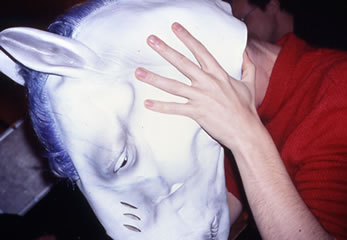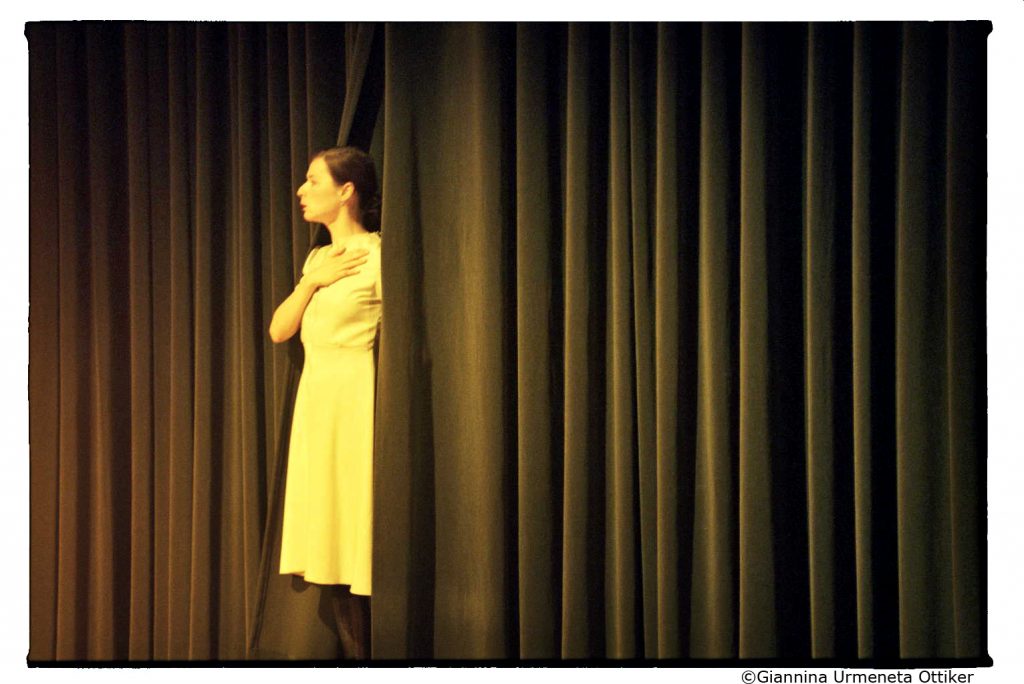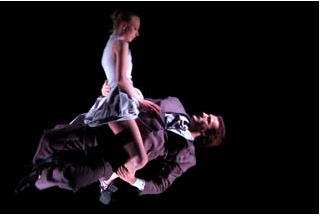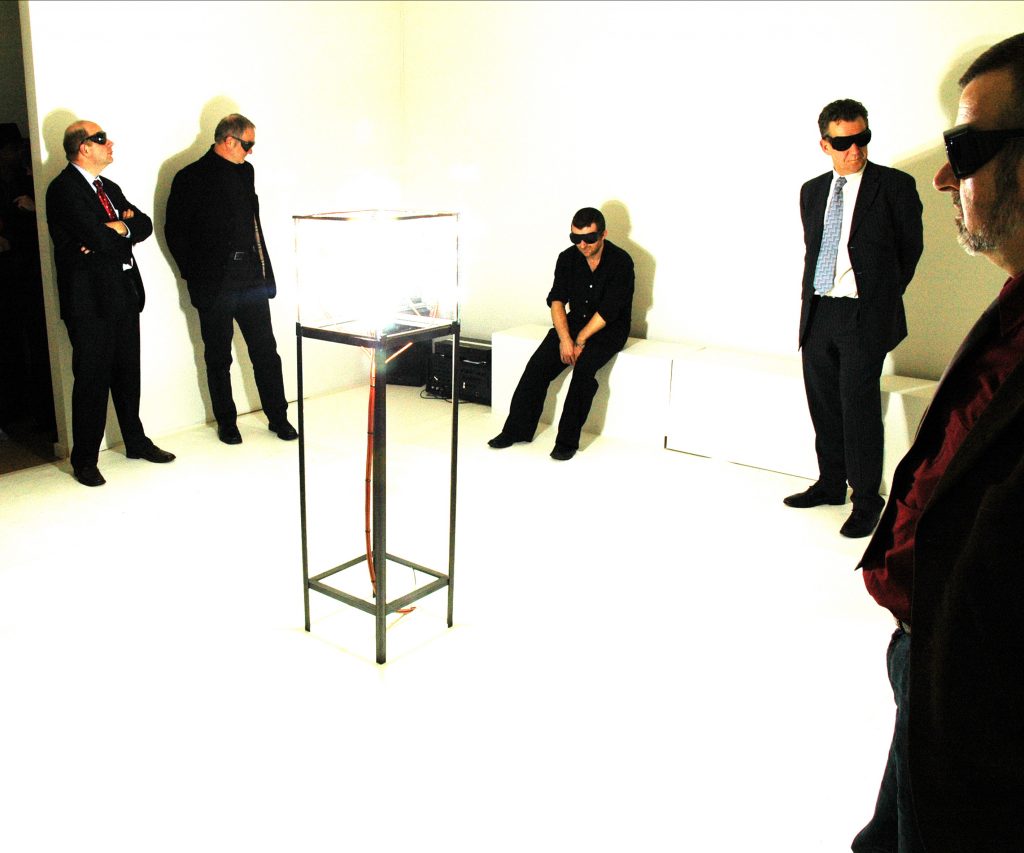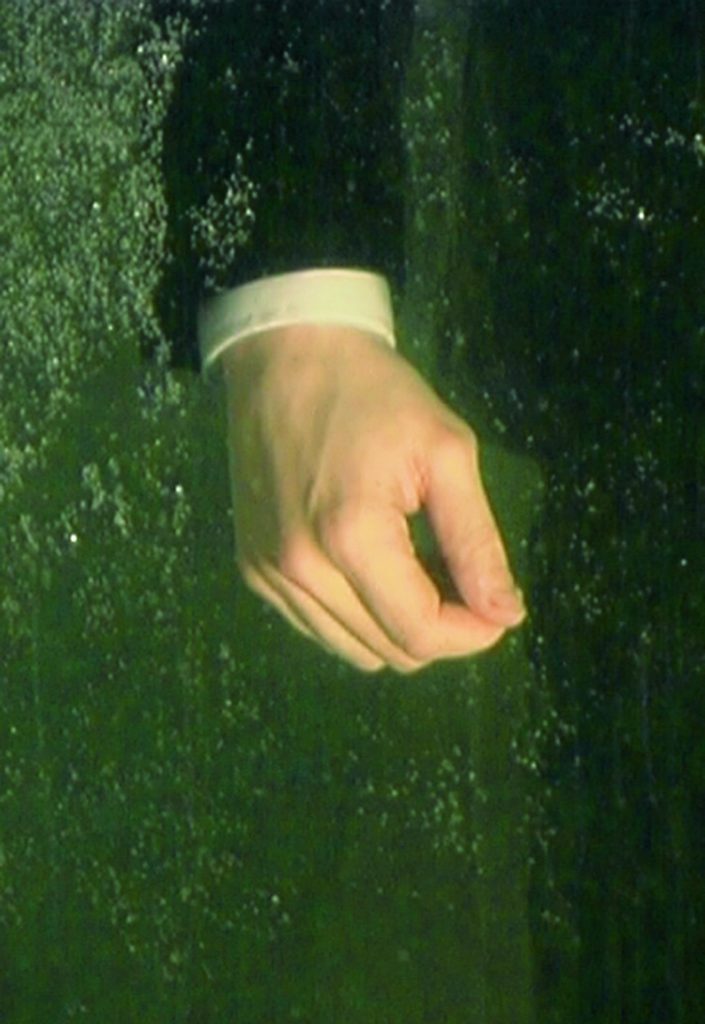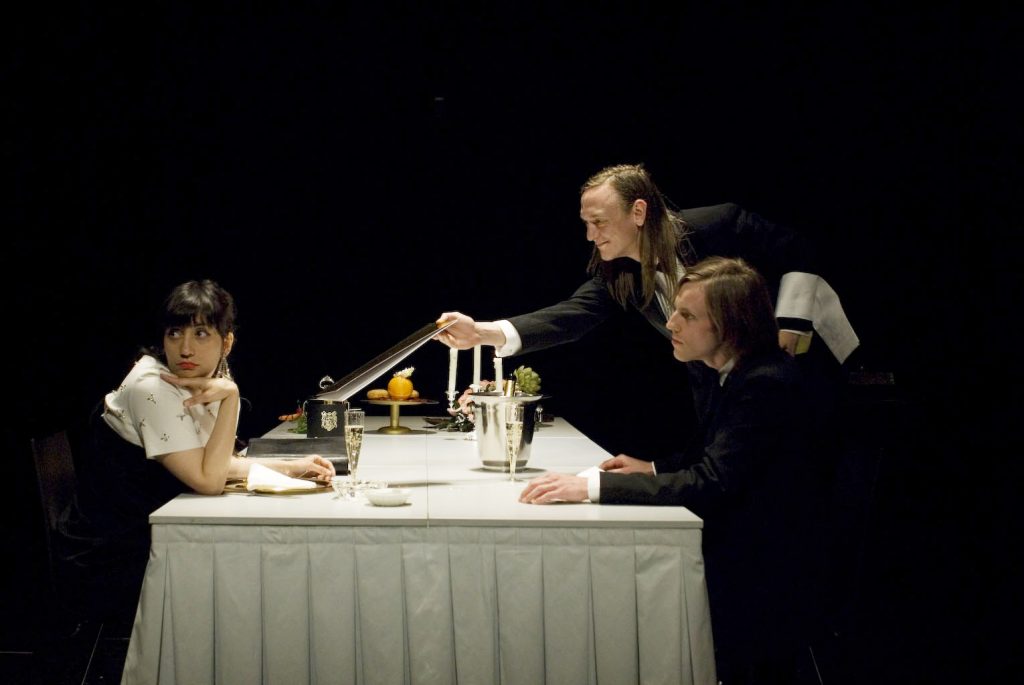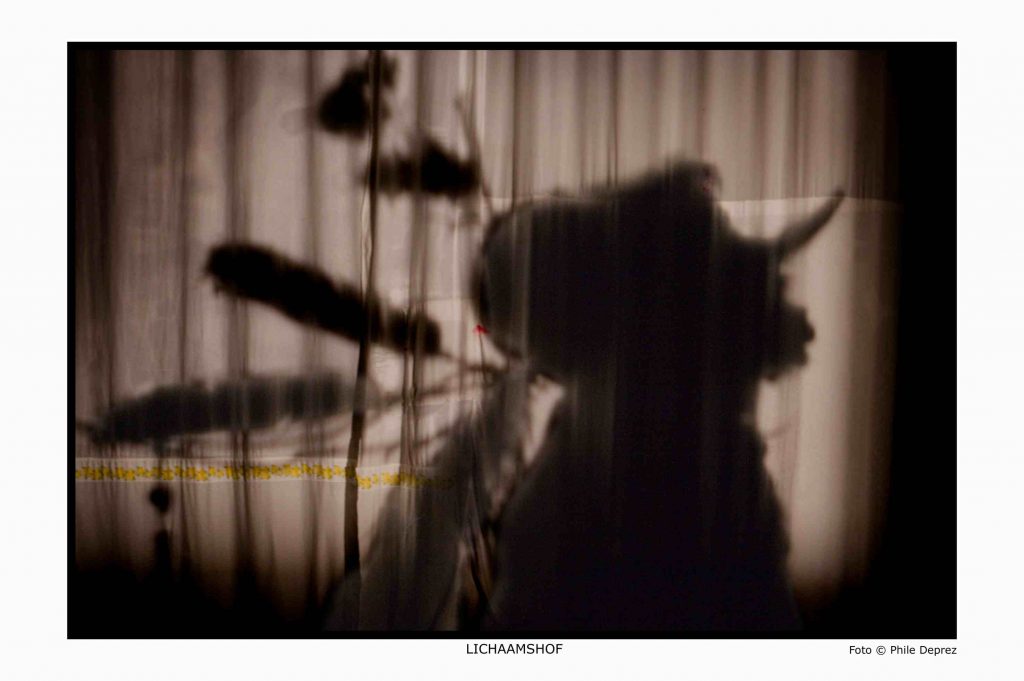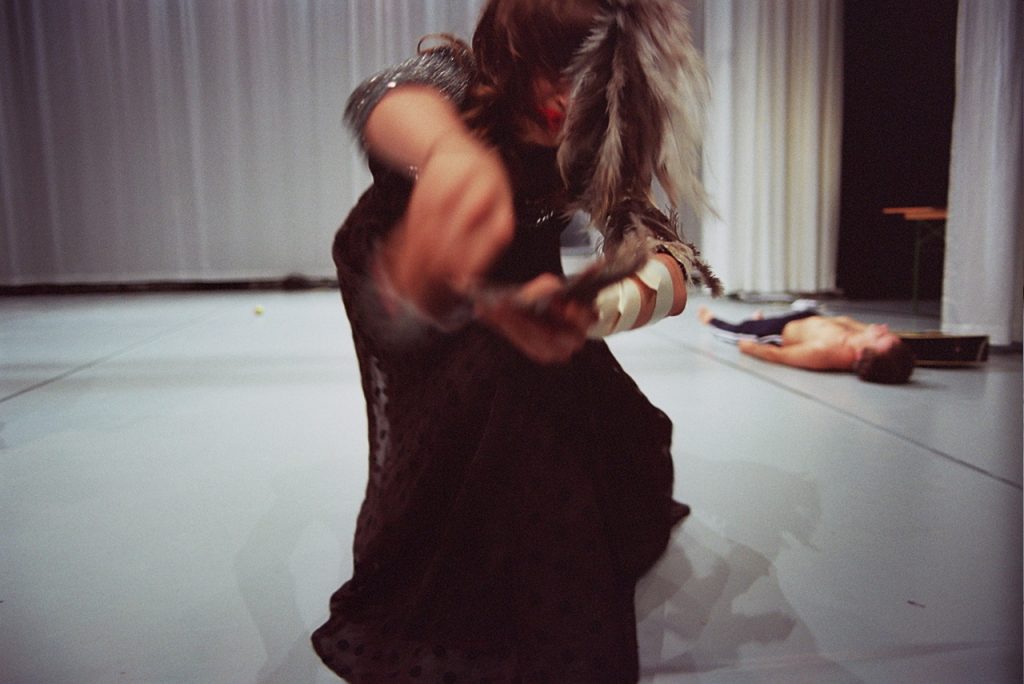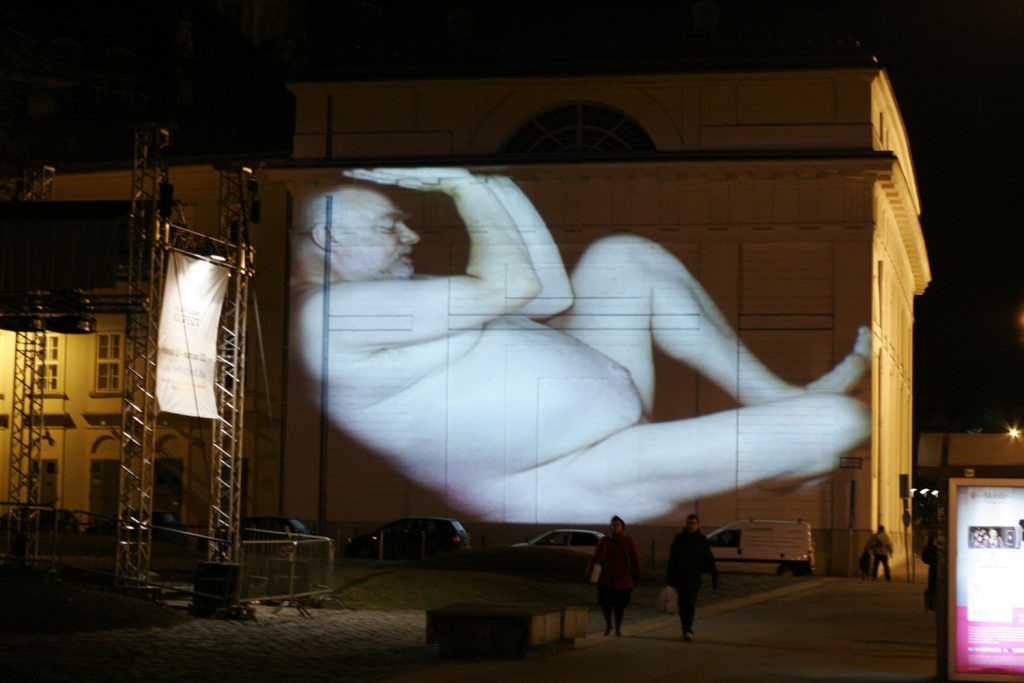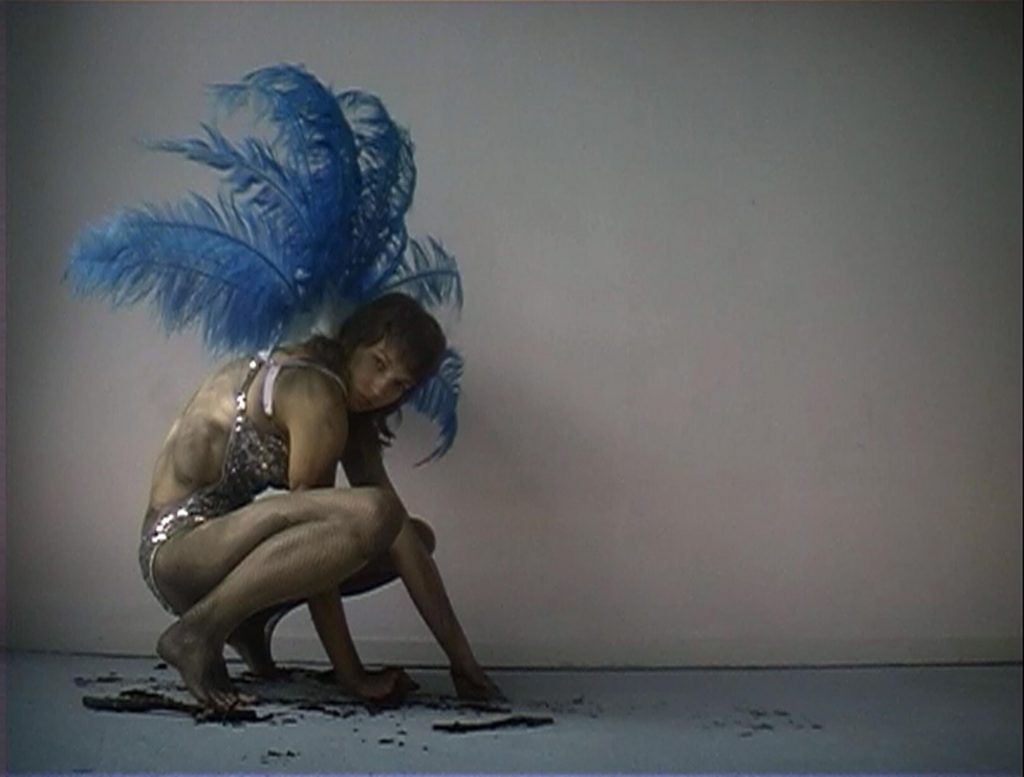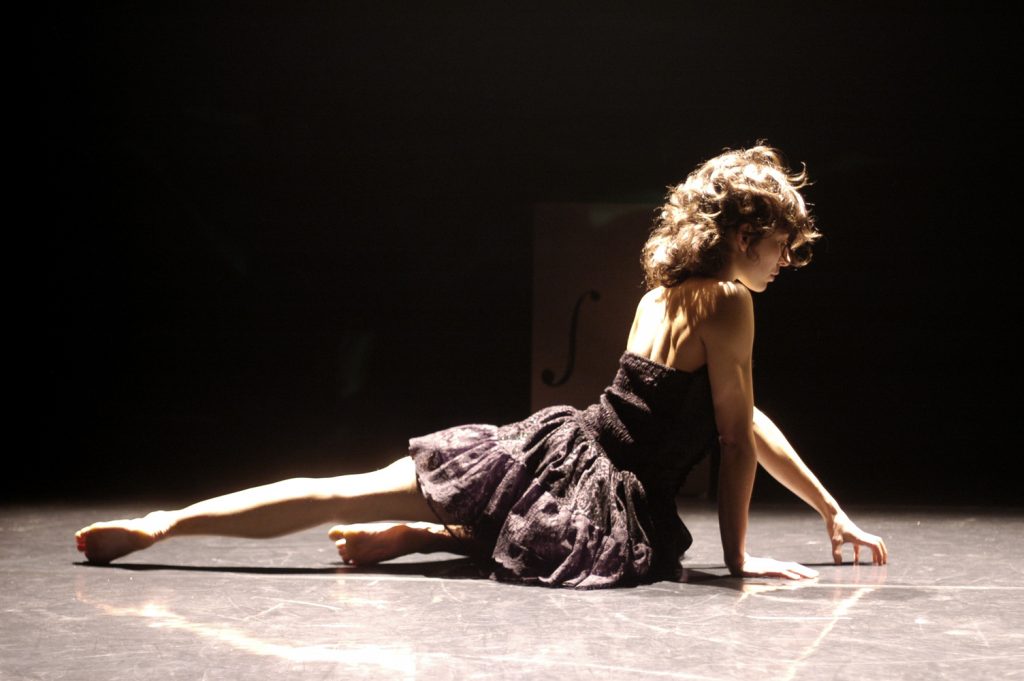Over the years, the young performer Hans Bryssinck has accumulated snapshots of friends and family and records of his projects. In Silent Manifesto you see a slide-show using several projectors. In between times Bryssinck tells of minor incidents and greater events.
An intimate performance that reflects on the little idiosyncrasies of the human mind that enable you to see things in a different way.
Agenda
Filter by artist
Sterven in Stijl (To die in style) is a solo by Hans Bryssinck and Dolores Bouckaert. Sterven in Stijl shows an actress wandering round between various scenes that increasingly head for her death: fragments of memories, lost loves and a last confession.
1) Some different aspects of the installation HEART : A man and a woman are connected to each other with a rope, a steal cable, between them a ‘winch’, she stands in front of the audience, he on a ladder behind the curtains: when he jumps, she is pulled backwards 9m and 4m high and smashes against a wall. The man is invisible to the woman, but sometimes she felt when he wanted to jump.
2) The structure of the classical ‘pas de deux’: from this heavily coded material different movements will be distilled.
DESCRIPTION
A man and woman are in a situation of absolute mutual dependence. As opposed to the situation in HEART man and woman are visible for each other. They execute their dance movements in a live loop. These movements will be deconstructed and mechanically manipulated. The machine pushes them to repeat perfectly; for which they inevitably have to trust each other. They are left to each other.
1) Some different aspects of the installation HEART : A man and a woman are connected to each other with a rope, a steal cable, between them a ‘winch’, she stands in front of the audience, he on a ladder behind the curtains: when he jumps, she is pulled backwards 9m and 4m high and smashes against a wall. The man is invisible to the woman, but sometimes she felt when he wanted to jump.
2) The structure of the classical ‘pas de deux’: from this heavily coded material different movements will be distilled.
DESCRIPTION
A man and woman are in a situation of absolute mutual dependence. As opposed to the situation in HEART man and woman are visible for each other. They execute their dance movements in a live loop. These movements will be deconstructed and mechanically manipulated. The machine pushes them to repeat perfectly; for which they inevitably have to trust each other. They are left to each other.
Box is an installation: a glass cube contains the strongest possible light source that can be concentrated on such a small surface; the project was developed in collaboration with engineers of Philips Lightning (Turnhout). The spectators, equipped with protective, dark glasses, are led into the room. As they watch the light, they hear the voice of the actor Johan Leysen who speaks, in German, the apocalyptic texts by Heiner Müller Verkommenes Ufer and Landschaft mit Argonauten. The light that normally allows us to see, here blinds us. It could be the light flash of a nuclear explosion, a never ceasing, eye-burning lightning that announces the end of the world.
An actress remains motionless for an hour in a display window filled with water. The distortion to her senses caused by the environment she is in makes her go into a trance. The sounds of her breathing and movement are amplified by microphones.
Hans Bryssinck + Diederik Peeters + D. ANESIADOU
Chuck Norris doesn’t sleep, he waits…
Waar, voorwaar, zijn de discrete charmes van de bourgeoisie gebleven? In hun enigmatisch klinkende ensemblestuk “Chuck Norris Doesn’t Sleep, He Waits…” nemen Danai Anesiadou, Hans Bryssinck en Diederik Peeters elk om beurt de rol van de even decadent als cinematisch icoon waar. Centraal in hun draaiboek van even absurdistisch als streng gechoreografeerde tableaux vivants staat de filmische representatie van aristocratisch ennui.
In “Chuck Norris” dalen onze argeloze protagonisten af in een labyrintische onderwereld van archaïsche codes en ondoorzichtige rituelen; het enige licht aan het einde van deze eindeloos lopende tunnel is dat van ouderwetse, groteske horror: een hartelijk aanbevolen schouwspel van alledaagse verbijstering.
Wanneer u Het Lichaamshof bezoekt, kan u zich voor de duur van een verhaal onderdompelen in de geheime wereld van een hut, een afgesloten plek die onderdak biedt aan het erotisch-apocalyptisch spel van twee jonge meisjes, teruggaand op spookbeelden uit de kindertijd.
Het Lichaamshof is een onbekend territorium, een plek waar de leugen van een verhaal een hallucinatie wordt, waar de leugen de waarheid lijkt te zeggen, waar deze waarheid troost biedt en het gevoel geeft te leven. Het leven als een spel, waar men voor het genot het risico neemt van pijn te hebben, waar men om vrolijk te zijn het risico neemt van gek te worden.
De installatie Het Lichaamshof is een no man’s land waarvan de bewoners voor zichzelf een wereld hebben geconstrueerd met als enige referentiepunt de hut zelf.
Poni turns its guns on theatre. The key words in this performance are Ritual, Illusion and Death. How does one dismantle the rituals and obsessions of theatre? And what remains of classical themes, codes and tricks? What is the point of those curtains? What if the theatre itself does a striptease? And what illusions do we cling to, no matter what the price?
Themes: Death illusion and ritual
This triptych was absorbed, chewed and worked on by all members of the collective. This way, sub themes are created like circus, fairytales, memories/memory, religion, tennis, photography.
In short, Poni is engaged in a duel with theatre in a hybrid work that combines performance art, live rock music, dance and theatre.
Wanneer u Het Lichaamshof bezoekt, kan u zich voor de duur van een verhaal onderdompelen in de geheime wereld van een hut, een afgesloten plek die onderdak biedt aan het erotisch-apocalyptisch spel van twee jonge meisjes, teruggaand op spookbeelden uit de kindertijd.
Het Lichaamshof is een onbekend territorium, een plek waar de leugen van een verhaal een hallucinatie wordt, waar de leugen de waarheid lijkt te zeggen, waar deze waarheid troost biedt en het gevoel geeft te leven. Het leven als een spel, waar men voor het genot het risico neemt van pijn te hebben, waar men om vrolijk te zijn het risico neemt van gek te worden.
De installatie Het Lichaamshof is een no man’s land waarvan de bewoners voor zichzelf een wereld hebben geconstrueerd met als enige referentiepunt de hut zelf.
1) Some different aspects of the installation HEART : A man and a woman are connected to each other with a rope, a steal cable, between them a ‘winch’, she stands in front of the audience, he on a ladder behind the curtains: when he jumps, she is pulled backwards 9m and 4m high and smashes against a wall. The man is invisible to the woman, but sometimes she felt when he wanted to jump.
2) The structure of the classical ‘pas de deux’: from this heavily coded material different movements will be distilled.
DESCRIPTION
A man and woman are in a situation of absolute mutual dependence. As opposed to the situation in HEART man and woman are visible for each other. They execute their dance movements in a live loop. These movements will be deconstructed and mechanically manipulated. The machine pushes them to repeat perfectly; for which they inevitably have to trust each other. They are left to each other.
The Stills consist of gigantic projections: naked, voluminous human figures, imprisoned in a space which is much too small for them. They sometimes move slightly, seeking the most comfortable position in which to bear their uncertain situation. Still I & II was commissioned in September 2006 by La Notte Bianca in Rome. The pictures were projected onto one of the megalomaniac façades of the EUR, a suburb of Rome built by Mussolini. Despite their magnitude, the precarious position in which these naked, utterly fragile figures find themselves was in stark contrast to the self-assured, social-realist architecture. A similarly imposing and demagogically tainted location was sought – and found – in Brussels: the upper part of the Kunstberg.
A grinding wheel with a big steel L hangs from the ceiling. When the disc starts to turn, the L twirls round uncontrolled. The motor races but still tries to find its equilibrium, still tries to function despite the strangeness of the situation. However the machine does not succeed. It starts to take on the appearance of a classical hero in distress, with movement making the situation become more and more unbearable.
Los Viernes was scripted as one full day of urban experiences throughout Mexico-City; driving around, meeting people, giving lectures in universities, doing guided museum tours etc. On Friday the 21st Bryssinck & Peeters acted out the script and turned it into a performative experience. Exactly one week later, on Friday the 28th they tried to re-enact this original day as literally and as precisely as possible. They took the same taxi to meet the same people wearing the same clothes at exactly the same time in the same place to have the same conversations and so on. In other words: an attempt to meticulously copy 24 hours of metropolitan and urban reality.
In the video documenting this attempt the two main characters and their collaborators are fighting impossible fights both with the chaotic surroundings and with time itself. The question arises as to what status a fake day like ‘Friday the second’ should really be accorded, whether it can be robbed of its uniqueness and can be called fake at all. Thus Los Viernes ponders on the true nature or value of performance, documentation and film and it haughtily questions the supposedly singular nature of time’s arrow that unquestionably and unstoppably moves forward and onward.
Los Viernes was made for a group exhibition Storage and Display in Programa Art Center in Mexico City in February 2003, curated by Dieter Roelstraete from the MUHKA museum in Antwerp, Roger Willems and Iñaki Bonillas.
Soffici Immagini is a video installation in diptych. More than twenty women appear consecutively, every one of them revealing another woman in the mirror she’s holding. Women of all ages, all forms. All unique, but all women. The difference in the similar.
1) Some different aspects of the installation HEART : A man and a woman are connected to each other with a rope, a steal cable, between them a ‘winch’, she stands in front of the audience, he on a ladder behind the curtains: when he jumps, she is pulled backwards 9m and 4m high and smashes against a wall. The man is invisible to the woman, but sometimes she felt when he wanted to jump.
2) The structure of the classical ‘pas de deux’: from this heavily coded material different movements will be distilled.
DESCRIPTION
A man and woman are in a situation of absolute mutual dependence. As opposed to the situation in HEART man and woman are visible for each other. They execute their dance movements in a live loop. These movements will be deconstructed and mechanically manipulated. The machine pushes them to repeat perfectly; for which they inevitably have to trust each other. They are left to each other.
Over the years, the young performer Hans Bryssinck has accumulated snapshots of friends and family and records of his projects. In Silent Manifesto you see a slide-show using several projectors. In between times Bryssinck tells of minor incidents and greater events.
An intimate performance that reflects on the little idiosyncrasies of the human mind that enable you to see things in a different way.
Poni turns its guns on theatre. The key words in this performance are Ritual, Illusion and Death. How does one dismantle the rituals and obsessions of theatre? And what remains of classical themes, codes and tricks? What is the point of those curtains? What if the theatre itself does a striptease? And what illusions do we cling to, no matter what the price?
Themes: Death illusion and ritual
This triptych was absorbed, chewed and worked on by all members of the collective. This way, sub themes are created like circus, fairytales, memories/memory, religion, tennis, photography.
In short, Poni is engaged in a duel with theatre in a hybrid work that combines performance art, live rock music, dance and theatre.
Poni turns its guns on theatre. The key words in this performance are Ritual, Illusion and Death. How does one dismantle the rituals and obsessions of theatre? And what remains of classical themes, codes and tricks? What is the point of those curtains? What if the theatre itself does a striptease? And what illusions do we cling to, no matter what the price?
Themes: Death illusion and ritual
This triptych was absorbed, chewed and worked on by all members of the collective. This way, sub themes are created like circus, fairytales, memories/memory, religion, tennis, photography.
In short, Poni is engaged in a duel with theatre in a hybrid work that combines performance art, live rock music, dance and theatre.
A Las Vegas showgirl emerges from a month lost in the forest – muddy, disheveled and more animal than human. Somebody explains the expenses involved in being authentic. One woman reads pheromones. Another explains her ‘instinct for failure’.
The Stills consist of gigantic projections: naked, voluminous human figures, imprisoned in a space which is much too small for them. They sometimes move slightly, seeking the most comfortable position in which to bear their uncertain situation. Still I & II was commissioned in September 2006 by La Notte Bianca in Rome. The pictures were projected onto one of the megalomaniac façades of the EUR, a suburb of Rome built by Mussolini. Despite their magnitude, the precarious position in which these naked, utterly fragile figures find themselves was in stark contrast to the self-assured, social-realist architecture. A similarly imposing and demagogically tainted location was sought – and found – in Brussels: the upper part of the Kunstberg.
Crystalll was originally created as a black box performance,
referring directly to the history of stage representations of female
bodies, and using light effects to emphasize the magical appearance of
an “unreachable being”.
Poni turns its guns on theatre. The key words in this performance are Ritual, Illusion and Death. How does one dismantle the rituals and obsessions of theatre? And what remains of classical themes, codes and tricks? What is the point of those curtains? What if the theatre itself does a striptease? And what illusions do we cling to, no matter what the price?
Themes: Death illusion and ritual
This triptych was absorbed, chewed and worked on by all members of the collective. This way, sub themes are created like circus, fairytales, memories/memory, religion, tennis, photography.
In short, Poni is engaged in a duel with theatre in a hybrid work that combines performance art, live rock music, dance and theatre.
With How do you like my landscape Manah Depauw and Bernard Van Eeghem use sharp imagination to redefine the place of the human body within our society, which is still prey to a puritanical eye and political correctness. By means of slight manipulation – disconcerning by its simplicity – Depauw and Van Eeghem remove the human body from its normal context and place it in unexpected situations. The four-episode spectacle takes place around a landscape where the apparent tranquillity only serves to camouflage terrible beasts that, given a chance would awaken in us all those desires that we prefer to remain hidden. The audience follows a world that transforms itself and develops through the four episodes.
It began with a true story – a man found drowned in a shallow river, wearing a home-made fish-suit. This passionate yet doomed attempt to escape from his own human-ness was the sparking point for Hair From the Throat .
What happens if we want to escape human nature? The blurred distinction between animal and human appeals to us while at the same time filling us with distaste. In Hair from the Throat there is a plenty of experimentation with radical self-transformation and amateurish attempts at animalism.
Poni turns its guns on theatre. The key words in this performance are Ritual, Illusion and Death. How does one dismantle the rituals and obsessions of theatre? And what remains of classical themes, codes and tricks? What is the point of those curtains? What if the theatre itself does a striptease? And what illusions do we cling to, no matter what the price?
Themes: Death illusion and ritual
This triptych was absorbed, chewed and worked on by all members of the collective. This way, sub themes are created like circus, fairytales, memories/memory, religion, tennis, photography.
In short, Poni is engaged in a duel with theatre in a hybrid work that combines performance art, live rock music, dance and theatre.
It began with a true story – a man found drowned in a shallow river, wearing a home-made fish-suit. This passionate yet doomed attempt to escape from his own human-ness was the sparking point for Hair From the Throat .
What happens if we want to escape human nature? The blurred distinction between animal and human appeals to us while at the same time filling us with distaste. In Hair from the Throat there is a plenty of experimentation with radical self-transformation and amateurish attempts at animalism.
